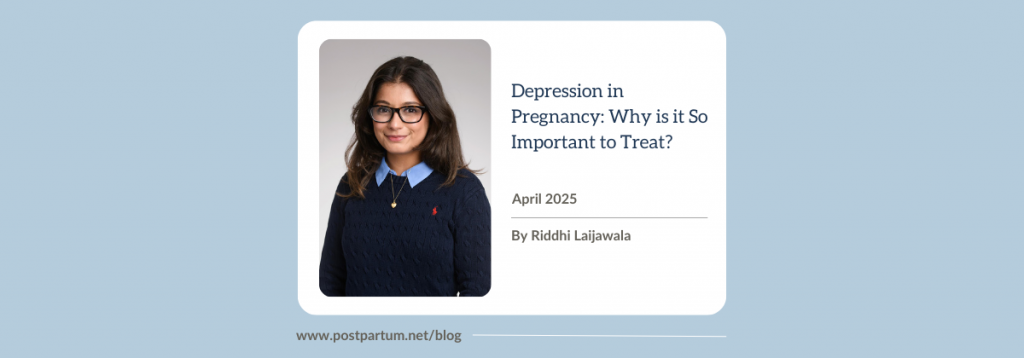By Riddhi Laijawala
As a researcher specialising in perinatal psychiatry, my work focuses on two key aspects of this period: pregnancy, and postpartum. I started off my career working on a randomized clinical trial assessing the efficacy of a community singing intervention (called SHAPER PND) on symptoms of postnatal depression. Now, I am part of the HappyMums consortium, which focuses on understanding antenatal depression (depression in pregnancy). I currently coordinate the UK’s arm of the HappyMums app study, where pregnant people at risk or currently experiencing depression are given access to a mobile application as a data collection tool. Working on this study has given me an in-depth understanding of depression in pregnancy, which is what I am going to talk about in today’s blog.

How many people does this affect?
Antenatal depression (AD) is estimated to affect close to 21% of pregnant people globally. In low and middle-income countries, this prevalence is higher, at nearly 25%. Further research has also shown that the prevalence of depression is higher in the first trimester, and reduces in the second and third trimesters.
You might wonder, what puts birthing people at risk of developing antenatal depression? Numerous literature have pointed to specific factors that put people more at risk of developing depression in pregnancy, such as history of abuse and violence, lack of social support, as well as history of psychiatric disorders. In addition to psychosocial risk factors, studies have found that women with pregnancy-specific/ obstetric complications are at higher risk of developing depression in pregnancy. These include conditions such as gestational diabetes and preeclampsia, as well as factors such as unintended pregnancy and prenatal smoking.
As with any condition associated with pregnancy, the next step is to understand its impacts on the mum and the baby.
The reason why I wanted to write on this topic is because my research has shown me how important it is to treat AD. This is because it affects not only the mum but also her baby.
Depression in pregnancy is one of the strongest risk factors for postnatal depression (PND). A recent review found that those who had depression in pregnancy were four times more likely to develop postpartum depression. These odds were higher when women experienced this in the first or the third trimester.
AD has also been discovered to have impacts through the developmental stages of life. Numerous research points to an increased likelihood of poor fetal and neonatal outcomes such as fetal growth restriction, preterm birth, and low birthweight, In the Apgar test, which is an assessment of the baby immediately after birth, researchers have discovered that babies born to mums who experienced severe AD had lower Apgar scores. In terms of longer-term impacts, studies have found that maternal depression in pregnancy can increase the likelihood of offspring depression in adolescence, as well as suboptimal cognitive, socio-emotional, and motor development in childhood.
One of my key research interests is understanding the role of mother-infant interaction in the context of perinatal mental illness. Decades of research have explained the integral role of mother-infant interaction in the first 1,001 days of life. A study undertaken by members of our lab here at KCL has shown that AD is associated with a reduced quality of mother-infant interaction, at both 8 weeks and 12 months after birth. Women with AD have lower levels of the hormone oxytocin (the bonding hormone), which could be one of the reasons why the interaction process could be impaired.
I am highlighting this evidence not to be a scaremonger, but to emphasise my point that there is a dire need to screen for depression in pregnancy so that people experiencing this can get the timely treatment they need and deserve. Barriers to accessing treatment must be addressed, and these women must get adequate treatment.

The takeaway: regular screening and timely intervention
So far, I have only shared some facts and figures. But where do we go from here? All this evidence points to the fact that women should be screened for antenatal depression, as a part of routine care. In the UK, the NHS has Perinatal Mental Health Services for pregnant and postnatal women with mental health conditions, aimed at treating mental health conditions and improving outcomes. This allows for women at risk to be regularly monitored, and to provide timely support and ensure their wellbeing, along with that of their baby. Along with being a period of intense biological changes, pregnancy is a period associated with numerous psychosocial changes as well. It is only when we integrate mental health services into routine prenatal care, that we will see an improvement in these numbers that I have shared early on. As individuals working in this field, it is important to know that the perinatal period has two equally important time points pregnancy, as well as postpartum.
Mums and their babies need the best well-being possible, and we must make every effort to ensure that.
If you are currently pregnant (13-28 weeks gestation) and based in the UK, please fill out our screening questionnaire to take part in the HappyMums study.
Perinatal Mental Health Signs and Symptoms
Peer Support Groups
Get Help










